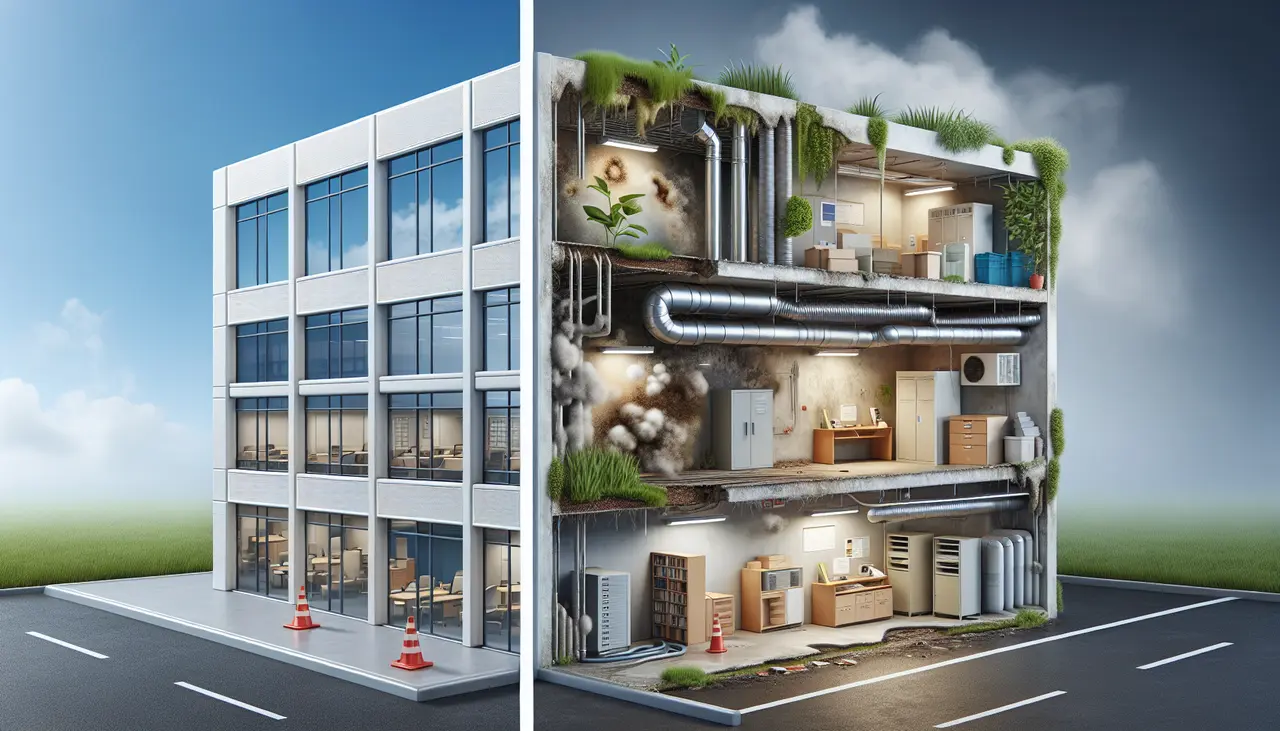Introduction to Mold in Commercial Buildings
Mold in commercial buildings is a sneaky enemy. It finds dark, damp places to grow and can spread quickly if not dealt with. Think about places like basements, bathrooms, and anywhere there might be leaks. Mold isn’t just ugly; it’s harmful. It can cause health problems for anyone who spends time in the building, like coughing, sneezing, and even serious lung issues. Plus, it can damage the building itself, eating away at materials and weakening the structure. It’s not something to ignore. The key to tackling mold is catching it early and taking action. This means keeping your building dry, fixing leaks fast, and ensuring good airflow. Mold might be hidden, but its dangers are very real. Understanding this sneaky intruder is the first step in protecting your health and your building.
The Health Risks of Mold Exposure
Mold in commercial buildings isn’t just a bad look—it’s a health hazard. When mold grows, it releases spores into the air. These spores can be breathed in, leading to a range of health problems, especially in people with asthma, allergies, or immune system issues. Here’s what you might face: respiratory problems, including coughing and wheezing; allergic reactions, marked by sneezing, red eyes, and skin rash; and for the more unlucky ones, serious infections. And it’s not just those with pre-existing conditions who should worry. Long-term exposure to mold can mess with even the healthiest person’s system, making mold something you don’t want to ignore. Keep it simple, spot mold, deal with it. Your lungs will thank you.
The Financial Impact of Mold on Businesses
Mold in commercial buildings isn’t just a health hazard – it’s a financial sinkhole too. When mold takes hold, the costs start stacking up fast. Think about it: you’ve got removal and remediation expenses, which aren’t pocket change. We’re talking serious money, especially for large areas. And that’s just the start. If the mold was caused by leaks or structural issues, fixing those can double your expenses. But wait, there’s more. Mold can hit businesses where it really hurts – operation disruptions. Imagine halting operations for cleanup, or worse, losing inventory. Those dollars add up fast. Also, consider the long-term implications. Property value takes a dive when mold’s involved, making it harder to sell or lease space. And let’s not forget about the legal and insurance headaches. Facing lawsuits from affected employees or customers? Your legal costs could soar, not to mention potential increases in insurance premiums or difficulties obtaining future coverage. So, when you spot mold, remember it’s not just an inconvenience, it’s a threat to your bottom line. Act fast to minimize the damage.
Common Areas Where Mold Thrives in Commercial Settings
In commercial buildings, mold is sneakier than you might think, finding its way into places you least expect. The main culprits? HVAC systems, carpets, and ceiling tiles. These areas provide the perfect mix of moisture and materials for mold to call home. First, HVAC systems, especially the ones that aren’t regularly cleaned or have leaks, give mold spores an express ticket to spread throughout the building. Second, carpets. They might give your office that cozy feel, but when they get wet and aren’t dried properly, they become a playground for mold. Lastly, those unassuming ceiling tiles can absorb moisture from leaks or high humidity, creating an ideal scenario for mold growth. Keep an eye on these areas to safeguard your workspace against the hidden dangers of mold.
Signs and Symptoms of Mold Presence
If you’re wondering whether your commercial building has a mold problem, pay attention to these signs. First, visible mold is the most obvious giveaway. It can look like small black or green spots spreading on walls, ceilings, or hidden corners. And if you think it smells damp or musty, like wet socks left in a gym bag, that’s another strong indicator mold’s taken hold. But mold isn’t just a surface issue; it can make people sick. Symptoms to watch for include: people coughing, sneezing, or reporting breathing issues, skin irritation like rashes, and even unexplained headaches or fatigue among those spending time in the building. These health complaints can often be the first sign that there’s a mold problem, even before it becomes visible or the smell gets obvious. Keep it simple: see something fuzzy, smell something musty, or hear health complaints? Time to check for mold.
Importance of Regular Inspections for Mold Prevention
Mold in commercial buildings is sneaky. You might not see it, but it’s there, lurking in damp corners, silently affecting the air everyone breathes. Regular inspections play a key role in mold prevention. Why? Because catching mold early stops it from becoming a bigger, costlier problem. Think of it this way: a small spot of mold can quickly spread through walls and HVAC systems, polluting the air in your building. This isn’t just about property damage; it’s about people’s health. Mold exposure can lead to breathing issues, skin irritation, and allergic reactions. By regularly checking hidden and visible areas for dampness and mold, you catch these problems early. This means easier, cheaper fixes and a healthier indoor environment for everyone. Plus, regular checks show your commitment to a safe, clean space, building trust with everyone who walks through your doors. In short, don’t wait for mold to become an obvious problem. Be proactive with regular inspections. It’s simpler, smarter, and ultimately safer.
Commercial Mold Removal: What It Involves
When you find mold in a commercial building, taking action fast is key. Mold removal, often called mold remediation, involves a few critical steps to ensure the building is safe and clean. First up, professionals will inspect and assess the mold damage. They’re looking for how much there is and where it’s hidden. After the assessment, they contain the mold to stop it from spreading throughout the building. This might mean physically covering areas or using air filters. Then comes the part where they actually remove the mold. This could involve scrubbing, using chemicals, or even cutting out parts of walls or flooring. After the mold is gone, they clean up everything, including items that got contaminated. Finally, they dry the areas out to make sure mold doesn’t come back. Each step is crucial not just for getting rid of the mold but making sure it stays gone. Mold in commercial buildings isn’t a small problem, so solving it isn’t simple. But, with the right team, it’s definitely doable.
Professional Versus DIY Mold Remediation: What’s Best for Your Business?
When mold creeps into your building, you’re faced with a choice: hire a pro or tackle it yourself. Each has its ups and downs. Hiring professionals means shelling out more cash upfront, but these folks know their mold. They come armed with the right tools, follow safety codes, and ensure the mold is gone for good. On the flip side, rolling up your sleeves to deal with mold personally can save money. However, it’s risky. If you don’t get all the mold, or if it’s a type that’s dangerous to touch or breathe, you might end up with a bigger problem. Plus, without the proper gear, you’re putting your health at risk. Bottom line: if the mold area is small and straightforward, a DIY approach could work. But for serious infestations, or if the mold’s of the nastier kind, calling in the pros is the smarter, safer bet.
Preventing Future Mold Problems in Your Facility
To keep mold from becoming an unwelcome guest in your commercial building, here’s what you need to know. First, make sure the building stays dry. Mold loves moisture, so tackle leaks as soon as they appear – whether they’re in roofs, windows, or pipes. Second, good ventilation is key. Especially in areas like kitchens, bathrooms, and laundry rooms, moving air helps keep moisture and mold at bay. Installing dehumidifiers in prone areas can also work wonders. Third, clean and maintain HVAC systems regularly. These systems can spread mold spores throughout your facility if they’re not properly taken care of. Lastly, keep an eye on indoor humidity levels. They should stay below 60 percent. A simple hygrometer can help you monitor this. Remember, mold prevention is a continuous effort. By staying proactive, you’ll save a lot of trouble and expenses down the road.
Conclusion: The Necessity of Addressing Mold Issues Promptly
Ignoring mold in commercial buildings isn’t just bad for the structure; it’s a health risk and a business liability. Keep in mind that mold can significantly harm people’s health, leading to allergies, respiratory issues, and worse for those with pre-existing conditions. Not only does this pose a direct threat to the wellness of employees and customers, but it also hits businesses where it hurts – in their reputation and their wallets. Reacting quickly to signs of mold, investigating its source, and taking decisive steps to remove it ensures a safe environment. Moreover, it protects the building’s integrity, safeguarding your investment. Bottom line, addressing mold issues promptly isn’t an option; it’s a necessity for the health of both people and buildings.






